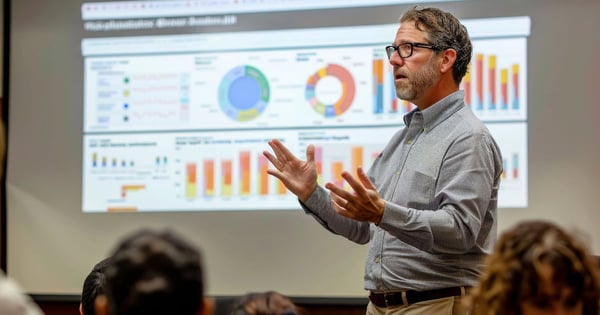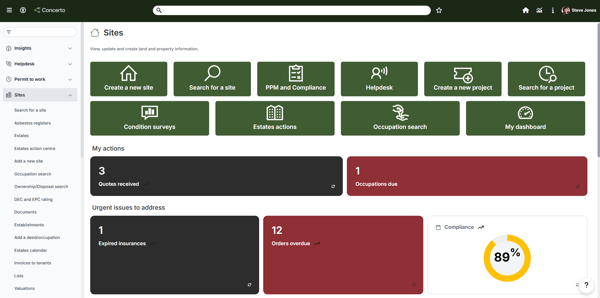
Talking estates strategy with Guys and St Thomas NHS
NHS estates in the spotlight: How Guys and St Thomas' is using data to build a smarter, greener future
In this latest episode of the Estates Data Strategy podcast series, Sophie Cook of GovNews and Matthew Dickinson of Bellrock dive into the world of NHS estates. Their guest is David Bourne, Assistant Director of Property and Asset Management at Guy's and St Thomas' NHS Foundation Trust (GSTT).
From managing an expansive and complex estate to pioneering sustainable solutions and embracing AI and data integration, David shares how GSTT is transforming its property portfolio to meet the needs of modern healthcare, while staying true to tight public sector budgets.
A vast and diverse NHS Estate
Guy's and St Thomas' is more than just a pair of iconic hospitals in the heart of London.
- Guy's Hospital near London Bridge
- St Thomas' Hospital opposite the Houses of Parliament
- Royal Brompton and Harefield Hospitals specialising in heart and lung care
- A community estate of 100+ buildings, including clinics, administrative offices and outreach sites reaching as far as Tunbridge Wells in Kent
Balancing cost and care
One of GSTT's greatest successes is managing to consistently balance its estates budget, a rare feat in the NHS. But, as David points out, it requires constant focus:
“We need to minimise the spend on our buildings so we can maximise our spend on patient care. That takes daily financial vigilance.”
The trust works closely with other NHS partners through the South East London Integrated Care Board and the Association of Chief Estate Surveyors (ACES) to share best practices and create a more unified, cost-efficient property strategy.
A data-driven strategy
Managing hundreds of sites and leases means data is essential but until recently, GSTT's data was siloed across multiple platforms. Now, the trust is embarking on a major digital transformation.
Key data initiatives include:
- Centralising lease data into a combined CAFM (Computer-Aided Facilities Management) system
- Condition monitoring of sites using CAD plans and asset databases
- Implementing desk and room booking systems to optimise use of administrative space
- Integrating with Epic, a trust-wide patient information system that shows where patients are seen, linking estates usage directly to patient care data
David calls Epic a game-changer:
“Epic gives us a much clearer view of how our community portfolio is used. That's where we'll really start turning the dial.”
Sustainability and the net zero pathway
With the NHS committed to achieving net zero direct emissions by 2040 and indirect emissions by 2045, GSTT is already implementing meaningful change.
Current sustainability initiatives include:
- Electrifying the patient transport fleet, supported by a new vehicle charging hub
- Switching to district heating networks at St Thomas'
- Exploring a Thames River-sourced heat pump system for Guy's Hospital
- Campaigns like Gloves Off, reducing unnecessary single-use PPE
“We want to create more reliable, energy-efficient systems for our patients and reduce our reliance on fossil fuels,” says David.
The role of AI and predictive tools
Looking ahead, AI and predictive analytics are set to play a bigger role. From monitoring air flow in operating theatres to anticipating maintenance issues, AI can help prevent failures before they disrupt services.
“AI will help us manage environmental comfort and predict issues before they escalate. It's all part of creating safer, smarter hospitals.”
Using external expertise, strategically
External consultants are used sparingly, with a clear rule of thumb: if the task is recurring and core, it should be managed in-house. But for specialist expertise, such as rights to light claims or non-domestic rating appeals external input has paid off.
GSTT recovered £9 million in rates and over £1 million from a light access claim, proving the value of targeted external advice.
Looking five years ahead
With plans underway to unify data systems, David sees the next five years as a time of opportunity.
“Our goal is to create an estate that's efficient, sustainable, and deeply integrated with clinical care. It's about making our buildings work harder for our patients and staff.
By using real-time data, better space utilisation and stronger collaboration across clinical teams, GSTT is set to lead by example in how NHS estates can support world-class healthcare.
A final word: celebrating the unsung heroes
David closed the discussion by highlighting the contributions of the 2,200 staff who quietly keep the trust running:
- 1.5 million meals cooked each year
- 161,000 partnering journeys
- 7 million surgical instruments sterilised
- And national awards for team members like Eddie Tai, Porter of the Year
“Our team plays a vital role in patient recovery. Their dedication is often unsung but it's time we celebrated it.”
Conclusion
Guy's and St Thomas' NHS Foundation Trust shows how estates strategy, when powered by good data and strong collaboration, can deliver better outcomes for both patients and the public purse. From net zero to AI, their journey is one that many in the public sector can learn from.
The People Behind the Buildings
The new podcast on the block, for all the estate and property geeks to listen to on their lunch break.


